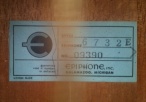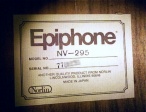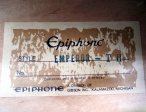Epiphone Serial Number Decoding
Contents |
Identifiers
YYMMFFRRRRR
In 2008 models begin to appear without a factory i.d. letter prefix.
- YY = Year of manufacture
- MM = Month of manufature
- FF = Factory I.D.
- RRRRR = Ranking number
Example: 08121520333 = 2008 / December / factory 15 / unit 20333
NOTE: Pre 1994 productions also frequently omitted factory letter codes and appeared as all numbers. e.g. 3042779
FYYMMRRRR
- F/FF = Factory code (No factory designator for some 1993 and earlier models)
- Y/YY = Year of manufacture (Single digit for some 1997 and earlier models)
- MM = Month of manufacture
- RRRR = Ranking number (may be more or less digits)
Example: 3021234 = Samick Korea / 1993 / February / unit 1234
Example: S3021234 = Samick Korea / 1993 / February / unit 1234
Example: S93021234 = Samick Korea / 1993 / February / unit 1234
Example: SI01021234 = Samick Indonesia / 2001 / February / unit 1234
Example: SI010212345 = Samick Indonesia / 2001 / February / unit 12345
FYYMRRRR
- F = Factory code
- YY = Year of manufacture
- M = Letter code to corresponding month (A = January, B = February, etc.)
- RRRR = Ranking number
Example: R01B0123 = Peerless Korea / 2001 / February / unit 0123.
FYYSSSS
Epiphone Elite/Elitist models
- F = Factory code (F = Fuji-gen, T = Terada)
- Y = Single digit year of manufacture (2002-2009)
- YY = Double digit year of manufacture (2010-Current)
- SSSS = Sequential ranking number
Example: F21234 = Fuji-gen Japan / 2002 / unit 1234
Example: T101234 = Terada Japan / 2010 / unit 1234
Factory Codes
FACTORY LETTER CODES
For Epiphone serial numbers that begin with a letter(s), this list identifies the factory & country where produced:
- B - Bohêmia Musico-Delicia (Czech Republic)
- BW - ____?____ (China)
- C - Cort
- CI - Cort (Indonesia)
- DW - DaeWon (China)
- EA - QingDao (China) = Epiphone Acoustic
- ED - Dongbei (China) = Chinese Dongbei means North-east.
- EE - QingDao (China) = Epiphone Electric
- F - Fuji-gen (Japan) = Elite/Elitist models (See: Epiphone Japan Serial Numbers)
- F - Qingdao (China) = Les Paul Standard '59 / '60 / Tribute Models (See: F-Serial used on LP Std'59/'60 models and Tribute/Plus models)
- F/FN - Fine Guitars (Korea) = non-Japanese models
- FC - ____?____ (China 2000's) Possibly "Global Fine Supply Ltd."
- FC - Fuji-Gen (Japan 1990's)
- H - _______ (China?) Found on a 1995 El Nino
- G/GG - Identified as early modern Masterbilt acoustics (Epiphone says they have no record of G serials)
- GR - Grand Reward (Farida, Guang Dong) China, Seen on some early Masterbilt acoustics
- GP - ____?____ (Korea) found on a BB King Lucille from 2001 (verified by Epiphone Customer Service)
- I - Saein (Korea)
- J - Terada Gakki Seisakusyo (Japan)
- J - Unknown. Possibly Jakarta, Indonesia - Found on a 1997 S-310
- JC - Unknown. Possibly Indonesia - Found on a 1998 Mini V
- JK - ??? Korea or Indonesia - Found on a 1999 G-310 Junior
- K - Korea Ins. (Korea)
- L - Leader Musical Instrument Co Ltd (Korea)
- MC - Muse (China)
- MR - Mirr factory, China
- N - See: FN
- O - Choice (Korea)
- P/R - Peerless (Korea)
- QG - Qingdao Gibson (China) - Interim designation used prior to "EA" & "EE"
- S - Samick (Korea)
- SI - Samick (Bogor, Indonesia)
- SJ - SaeJun (China)
- SK - ???
- SM - Samil (Korea)
- SN - ____?____ (Indonesia)
- T - Terada Gakki Seisakusyo (Japan)
- U - Unsung (Korea)
- UC - Unsung China (China)
- WF - ____?____ (China) found on an Accu Bass Junior from 2001
- X - ____ (China) - Early to mid 1990's serial number label - Verified by Epiphone Customer Service. Seen on "Epi" brand guitars.
- Y - Korea (seen on a PR775CE)
- Z - Zaozhuang Saehan (China)
FACTORY NUMBER CODES
For some models starting in 2008, if serial begins with numbers.
NOTE: The factories identified by these codes are based on patterns which forum members have observed. The numbers appear as the 5th and sixth digits in the serial number.
- 11 = MIC sticker on a '08 Masterbuilt 500
- 12 = DeaWon or Unsung (China -- uncertainty remains as to which factory)
- 13 = China - factory unknown
- 15 = Qingdao (China) -- electric
- 16 = Qingdao (China) -- acoustic
- 17 = China - factory unknown MIC sticker on a J160E
- 18 = China - factory unknown found on one 2009 model bass
- 20 = DaeWon or Unsung (China -- uncertainty remains as to which factory)
- 21 = Unsung, Korea
- 22 = Korea (factory still unknown)
- 23 = Samick factory Indonesia
- I = Indonesia (this letter has appeared as the 5th digit on two authentic new models made in Indonesia)
F-Serial used on LP Std'59/'60 models and Tribute/Plus models
This newest serial number system used by Epiphone is not yet completely deciphered.
'F' doesn't refer to 'Fine, Korea' - nor to 'Fuji-gen, Japan' - New "F" models are made in China.
This serial number system doesn't exactly tell the year - and doesn't tell the month at all.
- Beginning with F300000 in late 2009 used on LP Std'59/Std'60/Tribute models
- Continued around F310650~F311050 in spring 2012 on Tribute-Plus models
- Continued around F305000 in 2011
- Continued around F310000 in 2012
- Continued around F317000 in 2013
- Continued around F324000 in 2014
- Continued around F330000 in 2015
Epiphone Japan Serial Numbers
1998-Current
The Yamano Gakki Epiphone Japan serial numbers from 1998 onwards are in a YMMPPP format.
Y = Year of manufacture
MM = Month of manufacture
PPP = Production number
The serial number letters used by the Terada and Fuji-Gen guitar factories are:
- J = Terada
- T = Terada,
- F = Fuji-Gen
- No Letter = Fuji-Gen
Example: J902123 = Terada / 1999 / February / unit 123
Example: T902123 = Terada / 1999 / February / unit 123
Example: F902123 = Fuji-Gen / 1999 / February / unit 123
Example: 902123 = Fuji-Gen / 1999 / February / unit 123
1987-1997
For Yamano Gakki Epiphone Japan semi acoustic models from 1987 to approximately 1997, the serial numbers are in a YCPPP format.
They were made by Terada and usually have an Orange Epiphone label.
Y = Year of manufacture
C = Model code
PPP = Production number
Model Codes (C)
- 1 = NVJ
- 2 = EMPEROR
- 3 = RIVIERA
- 4 = SHERATON
- 5 = CASINO
- 6 = Limited Edition
- 7 = EB-2
- 8 = ES-930J
- 9 = EMPEROR-J
Example: 34123 = 1993 / SHERATON / unit 123
Example: 38123 = 1993 / ES-930J / unit 123
1971-1987
|
The Aria Epiphone Japan models that were made by Matsumoku from the early 1970s and ending before 1987 do not have a reliable serial numbering system but can be approximately dated using their Epiphone label colours.
The early Japanese blue labels were left over from production at the Kalamazoo factory and were used on Japanese-made instruments until supplies ran out (approximately 1970-1971). These labels say "Union Made" in the lower left corner and are sometimes hand-stamped with "Made in Japan" at the bottom. Some of the interim blue lables had neither the "Union Made" nor "Made in Japan" markings on them. When supplies ran out, these labels were replaced with a new batch that were printed "Made in Japan" in the lower right corner. Pre-1970 "Union Made" labels are distinguishable from labels used on Japanese intruments by the printed model name of the intrument only.
The Lincolnwood label was also used for the Tawainese "Epi" series acoustic guitars from 1979-1980. These labels say "Made in Tawain" in the bottom right corner. |
Refurbished Models
Serial numbers starting with '311xxxx' on a golden sticker are 'refurbished' guitars sold by MIRC (Musical Instrument Reclamation Center)
- There is no way to tell the year or the month it was made in the MIRC serial
- Original serial numbers are usually defaced
- Original warranty void
- Sometimes the word "2nd" is stamped on back of headstock
- MIRC specs can often be different from stock specs
Electrics | Archtops | Acoustics | Basses | Bluegrass | Amplifiers | Promotional Guitars




